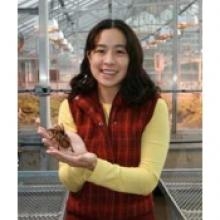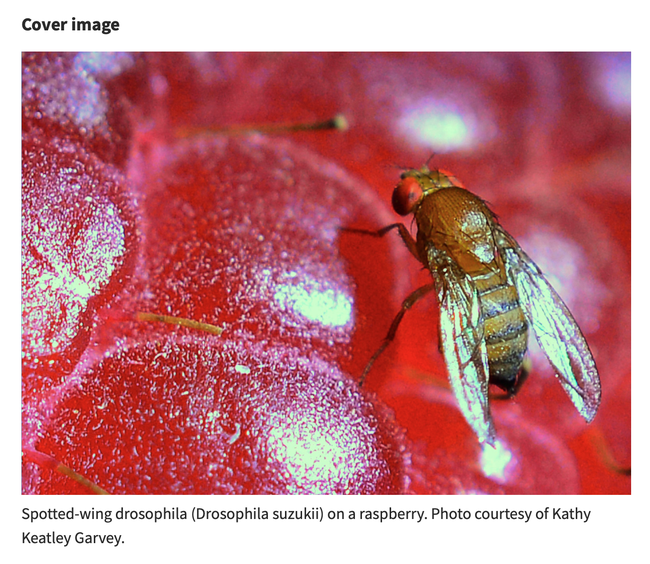
The project? Fourteen articles in The Journal of Economic Entomology's Special Collection: Research Advances in Spotted-Wing Drosophila suzukii Management, published in the August 2022 edition.
The insect? It's native to Asia and primarily targets soft-skinned fruits in the berry industry, such as raspberries, blackberries, blueberries, strawberries, and cherries. The tiny insect, about 1/12 to 1/8 inch long, invaded the continental United States in 2008.
The authors? They're from eight countries: United States, Austria, Brazil, Canada, Italy, Spain, Sweden, and the United Kingdom and represent perspectives from universities, federal and state laboratories, growers, and pest product companies.
Thirteen UC Davis scientists or former affiliates are among the authors who contributed.
“All of the papers were by invitation of the co-editors of the special collection—Jana Lee, Cesar Rodrigue-Saona, and me,” said journal editor-in-chief Frank Zalom, a UC Davis distinguished professor emeritus and recall professor in the Department of Entomology and Nematology. Zalom's research includes the insect, Drosophila suzukii.
Lee, formerly with the UC Davis laboratory of the late chemical ecologist Steve Seybold, is a research entomologist with the Horticultural Crops Research Unit, U. S. Department of Agriculture, Agricultural Research Service, Corvallis. Rodriguez-Saona, who received his doctorate from UC Riverside, is an Extension entomologist with the Department of Entomology, Rutgers University, the State University of New Jersey.

One paper, Spatio-temporal Variation of Spinosad Susceptibility in Drosophila suzukii (Diptera: Drosophilidae), a Three-year Study in California's Monterey Bay Region, is from the Zalom lab and includes co-author, molecular geneticist and physiologist Joanna Chiu, professor and vice chair of the Department of Entomology and Nematology.

Since 2008, "D. suzukii has become a key economical pest of raspberries, blackberries, blueberries, strawberries, and cherries in the United States and worldwide," the editors wrote in their introductory remarks. "Not surprisingly, the number of publications has proliferated from 29 publications as of 2010 to 978 additional publications between 2011 and 2021 from a Web of Science search for ‘Drosophila suzukii.' While many publications are available, this special collection will highlight advances in D. suzukii pest management since its U.S. invasion. We solicited papers by open call and received 66 abstracts, and selected 14 papers covering: 1) review, 2) monitoring and risk, 3) behavioral control, 4) biological control, 5) cultural control, and 6) chemical control."
The editors pointed out that “Given that 14 years of research has accumulated since the continental U.S. invasion, it was fitting to include two reviews that provide a different scope than was covered in prior reviews on D. suzukii biological control (Lee et al. 2019, Wang et al. 2020), trapping (Burrack et al. 2020), cultural control (Schöneberg et al. 2021), and chemical ecology (Cloonan et al. 2018). This special collection is anchored by Tait et al. (2021), a review of the most promising methods as part of an Integrated Pest Management (IPM) strategy against D. suzukii across the world since 2008. The effectiveness, impact, sustainability, and present stage of development and implementation are discussed for each of the considered techniques, and insights for continued development are presented.”

The researchers related that the pest is a significant threat to California's berry production industry, which the California Department of Food and Agriculture (CDFA) valued at more than $2.8 billion in 2019. Caneberries, in particular, "are a preferred host of D. suzukii, and California accounts for 89.4 percent of all production in the United States, with the Monterey Bay region producing about half of the state's raspberries and blackberries (CDFA 2020). This pest has now spread to all major berry and cherry growing areas of the United States."
The collection is meant to serve "as a key reference point for entomologists across many institutions (e.g., academia, government, and industry) on important advances in D. suzukii pest management," according to the Entomological Society of America. "The articles in this collection will also provide scientists information on potential research gaps that will help guide future research directions on this important pest. The goal is to preserve and catalog articles on various aspects of D. suzukii pest management, i.e., monitoring, cultural control, chemical control, behavioral control, and biological control, that will be shared among entomologists."
Attached Images:
